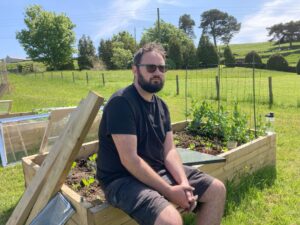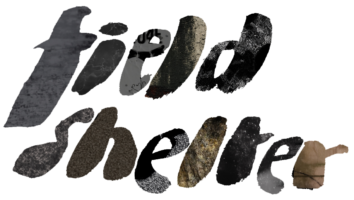about
click to expand
The Field Shelter is an artist-led creative studio and project space on Hadrian’s Wall, near Haltwhistle, Northumberland, UK. It is housed within a rural, off-grid building which was once a derelict stable. It presents a unique opportunity for people to visit a different kind of contemporary arts space; one which does not conform to the trappings of traditional galleries, but instead presents art-making in a rural setting, incorporating the challenges and benefits that come from existing in the wild, natural landscape of the rural north-east.
The space is used primarily as a working studio, with space and equipment to make and create. At one end there is permanent storage and workspace, and at the other, there is flexible space with good lighting that can be used for various activities, including:
– Hands-on workshops for up to ten people seated around a large table
– Ample workspace for a visiting artist
– Seating up to 15 people for performance or film screening
– Displaying work in a pop-up exhibition
We are registered as a Community Interest Company (CIC) 16013810
who we are
click to expand


lydia brockless – founder, director, programme manager
ed corble – programme & practical support
influences and values
click to expand
this is very much a space which will grow organically based on the people who visit and the art that is made and shown here. lydia’s interests and experiences have and will inevitably also influence this too. you can find out about her work here
We’re looking to work with and learn from artists and people working with a range of themes and activities. these will include:
- nature, landscape, conservation
- food systems, agriculture
- alternative ways of teaching & learning
- history, archaeology, geology
- wellbeing, togetherness, care
being a new organisation, we are learning how to navigate our work and relationships as we go – we’re open to all kinds of projects, but our main goals are:
- creating spaces and opportunities for learning
- supporting artists both locally and nationally
- introducing our local communities to new, different and engaging art activities
- having a low impact on our natural environment
- growing projects slowly and with careful thought and consideration
story
click to expand
Field Shelter is the project of visual artist Lydia Brockless, and her partner, Ed Corble. The building itself sits on the field next to Bridge House, a guest house and accommodation provider on the Hadrian’s Wall National Trail.
Lydia moved to Bridge House with Ed and his parents in October 2022. The house had been established as a traditional bed and breakfast by the previous owner, so Lydia & Ed took over the running of this venture, providing accommodation largely for people walking the Roman Wall trail or exploring the local area.
Originally a pony stable built in the 1980s, the Field Shelter betrays a much deeper history of horse-keeping in this particular field. When Cawfields Quarry was active in producing whinstone for road-building projects, and coal-mining operations were being carried out down at Haltwhistle Burn, this field housed working horses who were involved in pulling wagons and other equipment used in the works.
There is a rich history in the area, from the Roman Wall to neolithic stone carvings, geological activity to the Border Reivers of the 13th-17th centuries. It’s a place brimming with fascinating stories.
The name ‘Field Shelter’ came simply from the way it was referred to within documentation on sale of the property. It felt right to keep this phraseology to point to its history of use, but also to ponder on the other meanings found in the words ‘Field’ and ‘Shelter’.
When we first moved here, the stable was split into two, and full of debris from animals who had been kept in the field over the years. The previous owner of the house had lived there for something like 12 years but had never once used the building. A local joiner (lovely glen) was employed to shore up the structure, remove the partition wall, and replace rotten base timbers; he also fitted insulation panels to the walls and ceiling.
Next, we boarded out the space using OSB and birch ply (very badly) – and some of this work was undone and redone by glen, who came back to fit second-hand double-glazed window units in the West-facing wall. These were essential to open up some natural light and ventilation. The small plastic windows in the East face were also replaced with double glazing, and one final large window installed behind one of the stable doors. A fully-glazed uPVC door stands behind the other stable door.
So why are all the windows hidden? Well, the Field Shelter sits just inside the border of the Northumberland National Park, and is visible from the Roman Wall which holds UNESCO World Heritage status; as such, buildings and permission for development is tightly monitored, and as a condition of the planning application for change of use of the building, I set out that it would be almost disguised as a stable when not in use, therefore creating minimal change to the agricultural landscape. The National Park seemed to like this idea, so permission was granted and the windows were installed behind shutters made from the outer tongue and groove cladding.
The next step was to bring power to the space; whilst we could have gone down the route of running power up from house, this would involve colossal cost and disruption with a lot of digging and drilling. It just wasn’t an option – so we called on our previous knowledge of off-grid solar battery systems (we have one in our camper van), and installed 400w solar panels on the South side, connecting to two leisure batteries, a charge controller, 1000w inverter and battery monitor. This system powers LED strip lights on the ceiling, phone and laptop chargers, desk lights and can support other small appliances such as glue gun, rotary tool, sewing machine, projector and soldering iron.
We’re calling it a ‘creative studio’ and ‘project space’ – these words describe briefly the sorts of things that might happen in the space. Art-making will be the central focus of the Field Shelter, but we acknowledge and strive to highlight the diversity and limitless scope of what ‘art-making’ can actually be. Field Shelter is for everyone, whether they identify themselves as an artist or not; it’s for thinking, making, reading, talking, doing and reflecting. It will be shaped by the people who visit and use the space.
